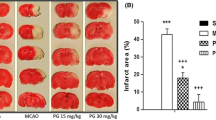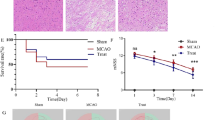Abstract
Increasing evidence demonstrates that inflammation plays an important role in cerebral ischemia. Carvacrol, a monoterpenic phenol, is naturally occurring in various plants belonging to the family Lamiaceae and exerts protective effects in a mice model of focal cerebral ischemia/reperfusion injury by reducing infarct volume and decreasing the expression of cleaved caspase-3. However, the anti-inflammatory mechanisms by which carvacrol protect the brain have yet to be fully elucidated. We investigated the effects of carvacrol on inflammatory reaction and inflammatory mediators in middle cerebral artery occlusion rats. The results of the present study showed that carvacrol inhibited the levels of inflammatory cytokines and myeloperoxidase (MPO) activity, as well as the expression of iNOS and COX-2. It also increased SOD activity and decreased MDA level in ischemic cortical tissues. In addition, carvacrol treatment suppressed the ischemia/reperfusion-induced increase in the protein expression of nuclear NF-kB p65. In conclusion, we have shown that carvacrol inhibits the inflammatory response via inhibition of the NF-kB signaling pathway in a rat model of focal cerebral ischemia. Therefore, carvacrol may be a potential therapeutic agent for the treatment of cerebral ischemia injury.



Similar content being viewed by others
References
Dirnagl, U., C. Iadecola, and M.A. Moskowitz. 1999. Pathobiology of ischaemic stroke: an integrated view. Trends in Neurosciences 22: 391–397.
Woitzik, J., T. Back, and C. Thome. 2007. Flow-dependent versus spreading-like impairment of brain tissue integrity during focal cerebral ischemia and its consequences for neuroprotective strategies. Frontiers in Bioscience 13: 1500–1506.
Danton, G.H., and W.D. Dietrich. 2003. Inflammatory mechanisms after ischemia and stroke. Journal Neuropathology and Experimental Neurology 62: 127–136.
Lakhan, S.E., A. Kirchgessner, and M. Hofer. 2009. Inflammatory mechanisms in ischemic stroke: therapeutic approaches. Journal of Translational Medicine 7: 97.
Lindsberg, P.J., and A.J. Grau. 2003. Inflammation and infections as risk factors for ischemic stroke. Stroke 34: 2518–2532.
Ultee, A., E. Kets, and E. Smid. 1999. Mechanisms of action of carvacrol on the food-borne pathogen Bacillus cereus. Applied Environmental Microbiology 65: 4606–4610.
Türkcü, G., U. Alabalık, A.N. Keleş, M. Bozkurt, İ. İbiloğlu, U. Fırat, and H. Büyükbayram. 2015. Protective effects of carvacrol and pomegranate against methotrexate-induced intestinal damage in rats. International Journal of Clinical Experimental Medicine 8: 15474–15481.
Lee, K.P., G.W. Sudjarwo, S.H. Jung, D. Lee, D.-Y. Lee, G.B. Lee, S. Baek, D.-Y. Kim, H.M. Lee, and B. Kim. 2015. Carvacrol inhibits atherosclerotic neointima formation by downregulating reactive oxygen species production in vascular smooth muscle cells. Atherosclerosis 240: 367–373.
Yin, Q.-h., F.-X. Yan, X.-Y. Zu, Y.-H. Wu, X.-P. Wu, M.-C. Liao, S.-W. Deng, L.-l. Yin, and Y.-Z. Zhuang. 2012. Anti-proliferative and pro-apoptotic effect of carvacrol on human hepatocellular carcinoma cell line HepG-2. Cytotechnology 64: 43–51.
Aristatile, B., A.H. Al-Assaf, and K.V. Pugalendi. 2013. Carvacrol suppresses the expression of inflammatory marker genes in D-galactosamine-hepatotoxic rats. Asian Pacific Journal of Tropical Medicine 6: 205–211.
da Silva Lima, M., L.J. Quintans-Júnior, W.A. de Santana, C.M. Kaneto, M.B.P. Soares, and C.F. Villarreal. 2013. Anti-inflammatory effects of carvacrol: evidence for a key role of interleukin-10. European Journal of Pharmacology 699: 112–117.
Guimarães, A.G., M.A. Xavier, M.T. de Santana, E.A. Camargo, C.A. Santos, F.A. Brito, E.O. Barreto, S.C. Cavalcanti, Â.R. Antoniolli, and R.C. Oliveira. 2012. Carvacrol attenuates mechanical hypernociception and inflammatory response. Naunyn-Schmiedeberg’s Archives of Pharmacology 385: 253–263.
Yu, H., Z.-L. Zhang, J. Chen, A. Pei, F. Hua, X. Qian, J. He, C.-F. Liu, and X. Xu. 2012. Carvacrol, a food-additive, provides neuroprotection on focal cerebral ischemia/reperfusion injury in mice. PLoS ONE 7, e33584.
Clark, W.M., N.S. Lessov, M.P. Dixon, and F. Eckenstein. 1997. Monofilament intraluminal middle cerebral artery occlusion in the mouse. Neurological Research 19: 641–648.
Perera, M.N., H.K. Ma, S. Arakawa, D.W. Howells, R. Markus, C.C. Rowe, and G.A. Donnan. 2006. Inflammation following stroke. Journal of Clinical Neuroscience 13: 1–8.
Zoppo, G., I. Ginis, J.M. Hallenbeck, C. Iadecola, X. Wang, and G.Z. Feuerstein. 2000. Inflammation and stroke: putative role for cytokines, adhesion molecules and iNOS in brain response to ischemia. Brain Pathology 10: 95–112.
Arvin, B., L.F. Neville, F.C. Barone, and G.Z. Feuerstein. 1996. The role of inflammation and cytokines in brain injury. Neuroscience & Biobehavioral Reviews 20: 445–452.
Saito, K., K. Suyama, K. Nishida, Y. Sei, and A.S. Basile. 1996. Early increases in TNF-α, IL-6 and IL-1β levels following transient cerebral ischemia in gerbil brain. Neuroscience Letters 206: 149–152.
Yenari, M.A., J. Liu, Z. Zheng, Z.S. Vexler, J.E. Lee, and R.G. Giffard. 2005. Antiapoptotic and anti‐inflammatory mechanisms of heat‐shock protein protection. Annals of the New York Academy of Sciences 1053: 74–83.
Matsuo, Y., H. Onodera, Y. Shiga, M. Nakamura, M. Ninomiya, T. Kihara, and K. Kogure. 1994. Correlation between myeloperoxidase-quantified neutrophil accumulation and ischemic brain injury in the rat. Effects of neutrophil depletion. Stroke 25: 1469–1475.
Salvemini, D., T.P. Misko, J.L. Masferrer, K. Seibert, M.G. Currie, and P. Needleman. 1993. Nitric oxide activates cyclooxygenase enzymes. Proceedings of the National Academy of Sciences of United States of America 90: 7240–7244.
Iadecola, C., F. Zhang, S. Xu, R. Casey, and M.E. Ross. 1995. Inducible nitric oxide synthase gene expression in brain following cerebral ischemia. Journal of Cerebral Blood Flow & Metabolism 15: 378–378.
Nogawa, S., F. Zhang, M.E. Ross, and C. Iadecola. 1997. Cyclo-oxygenase-2 gene expression in neurons contributes to ischemic brain damage. Journal of Neuroscience 17: 2746–2755.
Nakayama, M., K. Uchimura, R.L. Zhu, T. Nagayama, M.E. Rose, R.A. Stetler, P.C. Isakson, J. Chen, and S.H. Graham. 1998. Cyclooxygenase-2 inhibition prevents delayed death of CA1 hippocampal neurons following global ischemia. Proceedings of the National Academy of Sciences of United States of America 95: 10954–10959.
Adibhatla, R.M., and J. Hatcher. 2006. Phospholipase A 2, reactive oxygen species, and lipid peroxidation in cerebral ischemia. Free Radical Biology & Medicine 40: 376–387.
Chan, P.H. 2001. Reactive oxygen radicals in signaling and damage in the ischemic brain. Journal Cerebral Blood Flow and Metabolism 21: 2–14.
Harari, O.A., and J.K. Liao. 2010. NF‐kB and innate immunity in ischemic stroke. Annals of New York Academy of Sciences 1207: 32–40.
Ridder, D., and M. Schwaninger. 2009. NF-kB signaling in cerebral ischemia. Neuroscience 158: 995–1006.
Hu, X., O. Nesic‐Taylor, J. Qiu, H.C. Rea, R. Fabian, D.K. Rassin, and J.R. Perez‐Polo. 2005. Activation of nuclear factor‐kB signaling pathway by interleukin‐1 after hypoxia/ischemia in neonatal rat hippocampus and cortex. Journal of Neurochemistry 93: 26–37.
Xu, M., L. Yang, L.-Z. Hong, X.-Y. Zhao, and H.-L. Zhang. 2012. Direct protection of neurons and astrocytes by matrine via inhibition of the NF-kB signaling pathway contributes to neuroprotection against focal cerebral ischemia. Brain Research 1454: 48–64.
Sun, B.-Z., L. Chen, Q. Wu, H.-L. Wang, X.-B. Wei, Y.-X. Xiang, and X.-M. Zhang. 2014. Suppression of inflammatory response by flurbiprofen following focal cerebral ischemia involves the NF-kB signaling pathway. International Journal of Clinical and Experimental Medicine 7: 3087–3095.
Herrmann, O., B. Baumann, R. de Lorenzi, S. Muhammad, W. Zhang, J. Kleesiek, M. Malfertheiner, M. Köhrmann, I. Potrovita, and I. Maegele. 2005. IKK mediates ischemia-induced neuronal death. Nature Medicine 11: 1322–1329.
Author information
Authors and Affiliations
Corresponding author
Rights and permissions
About this article
Cite this article
Li, Z., Hua, C., Pan, X. et al. Carvacrol Exerts Neuroprotective Effects Via Suppression of the Inflammatory Response in Middle Cerebral Artery Occlusion Rats. Inflammation 39, 1566–1572 (2016). https://doi.org/10.1007/s10753-016-0392-5
Published:
Issue Date:
DOI: https://doi.org/10.1007/s10753-016-0392-5




